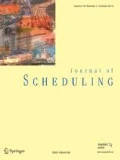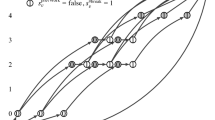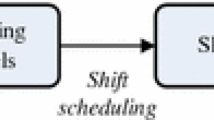Abstract
We consider a multi-activity shift scheduling problem where the objective is to construct anonymous multi-activity shifts that respect union rules, satisfy the demand and minimize workforce costs. An implicit approach using adapted forward and backward constraints is proposed that integrates both the shift construction and the activity assignment problems. Our computational study shows that using the branch-and-bound procedure of CPLEX 12.6 on the proposed implicit model yields optimal solutions in relatively short times for environments including up to 2970 millions of explicit shifts. Our implicit model is compared to the grammar-based implicit model proposed by Côté et al. (Manag Sci 57(1):151–163, 2011b) on a large set of instances. The results prove that both implicit models have their strengths and weaknesses and are more or less efficient depending on the scheduling environment.





Similar content being viewed by others
References
Aykin, T. (1996). Optimal shift scheduling with multiple break windows. Management Science, 42(4), 591–602.
Bechtold, S. E., & Jacobs, L. W. (1990). Implicit modeling of flexible break assignments in optimal shift scheduling. Management Science, 36(11), 1339–1351.
Bechtold, S. E., & Jacobs, L. W. (1996). The equivalence of general set-covering and implicit integer programming formulations for shift scheduling. Naval Research Logistics (NRL), 43(2), 233–249.
Cezik, T., & Günlük, O. (2004). Reformulating linear programs with transportation constraints with applications to workforce scheduling. Naval Research Logistics (NRL), 51(2), 275–296.
Côté, M. C., Gendron, B., Rousseau, L. M. (2007). Modeling the regular constraint with integer programming. In Integration of AI and OR techniques in constraint programming for combinatorial optimization problems (pp. 29–43). Berlin/Heidelberg: Springer.
Côté, M. C., Gendron, B., Quimper, C. G., & Rousseau, L. M. (2011a). Formal languages for integer programming modeling of shift scheduling problems. Constraints, 16(1), 54–76.
Côté, M. C., Gendron, B., & Rousseau, L. M. (2011b). Grammar-based integer programming models for multiactivity shift scheduling. Management Science, 57(1), 151–163.
Côté, M. C., Gendron, B., & Rousseau, L. M. (2013). Grammar-based column generation for personalized multi-activity shift scheduling. INFORMS Journal on Computing, 25(3), 461–474.
Dahmen, S., & Rekik, M. (2015). Solving multi-activity multi-day shift scheduling problems with a hybrid heuristic. Journal of Scheduling, 18, 207–223.
Dantzig, G. B. (1954). Letter to the editor-a comment on Edie’s traffic delays at toll booths. Journal of the Operations Research Society of America, 2(3), 339–341.
Demassey, S., Pesant, G., Rousseau, L. M. (2005). Constraint programming based column generation for employee timetabling. In Second international conference, CPAIOR 2005, May 2005, Prague, Czech Republic. Lecture Notes in Computer Science (Vol. 3524, pp. 140–154). Berlin/Heidelberg: Springer.
Ernst, A. T., Jiang, H., Krishnamoorthy, M., & Sier, D. (2004). Staff scheduling and rostering: A review of applications, methods and models. European Journal of Operational Research, 153(1), 3–27.
Fischetti, M., Liberti, L. (2012). Orbital shrinking. In Combinatorial optimization (pp. 48–58). New York, NY: Cambridge University Press.
Lequy, Q., Bouchard, M., Desaulniers, G., Soumis, F., & Tachefine, B. (2012). Assigning multiple activities to work shifts. Journal of Scheduling, 15(2), 239–251.
Moondra, S. L. (1976). An lp model for work force scheduling for banks. Journal of Bank Research, 7(4), 299–301.
Quimper, C. G., & Rousseau, L. M. (2010). A large neighbourhood search approach to the multi-activity shift scheduling problem. Journal of Heuristics, 16(3), 373–392.
Rekik, M., Cordeau, J. F., & Soumis, F. (2004). Using Benders decomposition to implicitly model tour scheduling. Annals of Operations Research, 128(1), 111–133.
Rekik, M., Cordeau, J. F., & Soumis, F. (2008). Solution approaches to large shift scheduling problems. RAIRO-Operations Research, 42(2), 229–258.
Rekik, M., Cordeau, J. F., & Soumis, F. (2010). Implicit shift scheduling with multiple breaks and work stretch duration restrictions. Journal of Scheduling, 13(1), 49–75.
Restrepo, M. I., Lozano, L., & Medaglia, A. L. (2012). Constrained network-based column generation for the multi-activity shift scheduling problem. International Journal of Production Economics, 140(1), 466–472.
Salvagnin, D., Walsh, T. (2012). A hybrid MIP/CP approach for multi-activity shift scheduling. In M. Milano (Ed.), Proceedings of the 18th international conference on principles and practice of constraint programming, CP 2012, Québec City, QC, Canada, October 8–12, 2012 (pp. 633–646). Berlin/Heidelberg: Springer.
Thompson, G. M. (1995). Improved implicit optimal modeling of the labor shift scheduling problem. Management Science, 41(4), 595–607.
Van den Bergh, J., Beliën, J., De Bruecker, P., Demeulemeester, E., & De Boeck, L. (2013). Personnel scheduling: A literature review. European Journal of Operational Research, 226(3), 367–385.
Acknowledgements
This work was supported by the Fonds de Recherche Nature et Technologie du Québec (FRNTQ) through its new researchers start-up grant. This support is gratefully acknowledged. The authors thank Louis Martin Rousseau, Marie-Claude Côté and Maria Isabel Restrepo for providing their benchmark and their source code, thus allowing a comparison with their grammar-based approach.
Author information
Authors and Affiliations
Corresponding author
Appendices
Appendix A: The grammar used to adapt the Côté et al. (2011) model to instances in the Dahmen set
All the grammars used are presented in accordance with the notations adopted by Côté et al. (2011). For clarity, they are not stated in Chomsky normal form. For each production P,‘\( \rightarrow _{S,[min,max]} \)’ restricts the subsequences generated to have a position belonging to the set of periods S and a span between min and max periods. When S or [min, max] are not specified for a production, there are no restrictions on its position or span, respectively. The grammar used for the Dahmen set with no restrictions on the number of activities, denoted \( \mathcal {G} \), is defined as follows:
When restrictions on the number of activities are considered (that is, \(NA_{am} , NA_{pm} = 2\)), some of the productions above defining \( \mathcal {G} \) are changed as follows:
Appendix B: Additional results for Section 6
Rights and permissions
About this article
Cite this article
Dahmen, S., Rekik, M. & Soumis, F. An implicit model for multi-activity shift scheduling problems. J Sched 21, 285–304 (2018). https://doi.org/10.1007/s10951-017-0544-y
Published:
Issue Date:
DOI: https://doi.org/10.1007/s10951-017-0544-y




